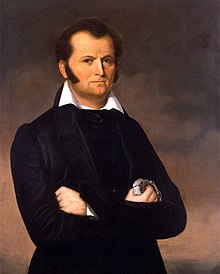Like many frontiersmen at the time, Bowie became intrigued by the idea of Texas. He went there and found plenty to keep him busy, including another land speculation scheme and the charms of Ursula Veramendi, the well-connected daughter of the mayor of San Antonio. By 1830 Bowie made a move to Texas, staying one step ahead of his creditors back in Louisiana. When he fought off a vicious Tawakoni Indian attack while searching for a silver mine, his fame and reputation as a tough frontiersman grew. In 1831 he married Ursula and took up residence in San Antonio: she would soon die tragically of cholera along with her parents.
Action in Nacogdoches
When disgruntled Texans attacked Nacogdoches in August of 1832 (they were protesting a Mexican order to give up their arms), Stephen F. Austin asked Bowie to intervene. Bowie arrived in time to capture some fleeing Mexican soldiers. This made Bowie a hero of those Texans who favored independence, although it is not necessarily what Bowie intended, as he had a Mexican wife and a lot of money in land in Mexican Texas. In 1835 open war broke out between rebellious Texans and the Mexican army. Bowie went to Nacogdoches, where he and Sam Houston were elected leaders of the local militia. He acted quickly, arming the men with weapons seized from the local Mexican armory.
Assault on San Antonio
Bowie and other volunteers from Nacogdoches caught up with a rag-tag army led by Stephen F. Austin and James Fannin: they were marching on San Antonio, hoping to defeat Mexican General Cos and end the conflict quickly. In late October 1835, they laid siege to San Antonio, where Bowie's contacts among the population proved extremely beneficial. Many residents of San Antonio joined the rebels, bringing valuable intelligence with them. Bowie and Fannin and some 90 men dug in on the grounds of Concepción Mission just outside the city: General Cos, spotting them there, attacked.
The Battle of Concepción and Capture of San Antonio
Bowie told his men to keep their heads and stay low. When the Mexican infantry advanced, the Texans devastated their ranks with accurate fire from their long rifles. The Texan sharpshooters also picked off artillerymen who were shooting the Mexican cannons. Disheartened, the Mexicans fled back to San Antonio. Bowie was once again hailed a hero. He was not there when Texan rebels stormed the city in the early days of December 1835, but he returned shortly after. General Sam Houston ordered him to demolish the Alamo, a fortress-like old mission in San Antonio, and a retreat from the city. Bowie, once again, disobeyed orders. Instead, he mounted a defense and fortified the Alamo.
Bowie, Travis, and Crockett
In early February, William Travis arrived in San Antonio. He would take over nominal command of the forces there when the ranking officer left. Many of the men there were not enlisted: they were volunteers, which meant that they answered to no one. Bowie was the unofficial leader of these volunteers, and he did not care for Travis. This made things tense at the fort. Soon, however, famous frontiersman Davy Crockettarrived. A skilled politician, Crockett was able to defuse the tension between Travis and Bowie. The Mexican Army, commanded by Mexican President/General Santa Anna, showed up in late February: this common enemy also united the defenders.
The Battle of the Alamo and Death of Jim Bowie
Bowie became very ill sometime in late February. Historians disagree about what illness he suffered from. It may have been pneumonia or tuberculosis. It was a debilitating illness, and Bowie was confined, delirious, to his bed. According to legend, Travis drew a line in the sand and told the men to cross it if they would stay and fight. Bowie, too weak to walk, asked to be carried over the line. After two weeks of siege, the Mexicans attacked the morning of March 6. The Alamo was overrun in less than two hours, and all of the defenders were captured or killed, including Bowie, who reportedly died in his bed, still feverish.
Podcast
- Abhi
- Branden
- Torurn

No comments:
Post a Comment